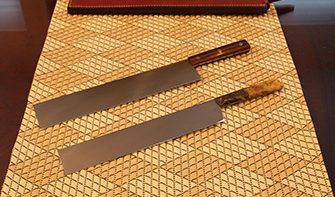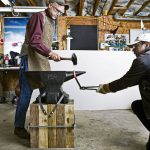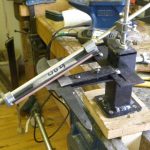To this day there is no food I miss more from the back house than Bailey’s bagel. It is considerably simpler to find a good, authentic southern biscuit in the North than it is to discover a decent bagel in the South *.
While how to appropriately make a bagel may be dictated by cultural tradition, Jewish dietary guidelines on meat, in particular, come as a religious essential. Less than a lot of makers worldwide make these specially-sanctioned blades, one of whom– Rabbi Moshe Yurman of Brooklyn, New York is a master of both crafting and using these specialized knives.
From Tabletmag.com:
Rabbi Moshe Yurman, 65, hasn’t screwed up a kosher chicken in decades. He slaughtered his first animal at 18 and has since butchered innumerable goats, cows, chickens, sheep, peafowl, pigeons, bulls, American bison, and buffalo: If it’s kosher, he has probably killed it.
Yurman got into animal slaughter for the knives. In addition to being a shochet, or slaughterer, he is one of only three ritual knife-makers in the United States. There are fewer than 10 worldwide.
The knife, known as the chalif, is the most important tool of the shochet. The chalif must be handmade and kept exquisitely sharp. In industrial kosher plants, a bell rings every three minutes reminding shochtim to check their knives. If a nick the size of a hairsbreadth is discovered, all animals killed since the last inspection are deemed not kosher. There are different knives for different animals. For chickens, the blade is about five inches long. A lamb, eight to 12. A full-sized cow would need at least an 18-inch blade. The same goes for a bull. A buffalo could exceed 19 inches. The ideal shechitah knife is roughly two-thirds the size of the animal’s neck.
Fewer than 300 men kill all the kosher meat sold in America, and they typically move every few months, working at plants in Iowa and Colorado, or outside the country in Canada, Mexico, and Uruguay. Owning and maintaining a set of knives is a matter of pride for a shochet, and each one—like a high-end chef—brings his own knife to work, no matter how large or professional the plant. The typical shochet can maintain his blade, but if he needs a new knife he comes to Yurman’s home in the Midwood area of Brooklyn. Choosing a knife is intimate business.

There is so much more than I want I could share here, but it would exceed my convenience level for Fair Use. I extremely suggest you read the entire thing. It is a wonderful example of the intersection of knives and culture.
*The closest I have actually discovered to a “real” bagel in Knoxville is Einstein Brothers, but these barely qualify as “bagel Methadone”. They are close adequate to stop the twitching, but I drool like Pavlov’s pet at the thought of the crispy crust and chewy goodness of Bailey’s bagel.


